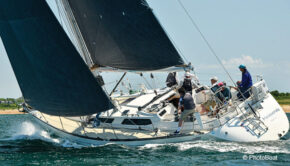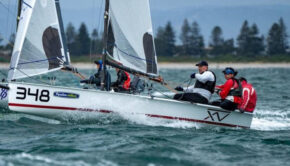How One Club Grew Their Racing Fleet
Published on March 8th, 2017
In the March 2017 newsletter of the Lake Michigan Sail Racing Federation, Ken Zimmerman and James Schrager share their story of successful fleet building.
A few years ago the sailing program at St. Joseph River Yacht Club in St. Joseph, Michigan, was at a low point.
The Spinnaker section had good participation but wasn’t growing. The Jib and Main fleet had just two boats sailing enough races to qualify for 2013 Boat of the Year, and at times brought only a handful of boats to the starting line in our Summer Series. It was clear we needed to start doing things differently.
Fast forward to 2016. We had eleven boats registered with nine boats sailing regularly in Jib and Main. Our Spinnaker section also grew, with thirteen boats registered and most racing regularly. Both of these are records for us, and this happened in spite of significant declines in racing all around the Lake.
Even more interesting, we achieved more competition in both fleets as well as growth. This means we didn’t just attract casual sailors–who are always most welcome to join us–but more serious racers as well willing to step up and challenge the existing leaders.
To get there, we developed four simple principles to organize our efforts along with four goals to guide us.
1. JIB AND MAIN IS DIFFERENT THAN SPINNAKER
We believe that JaM racers are different than Spinn sailors. First off, we scrapped the old notion that the singular goal of all JaM sailors was to “move up” to Spinn. The data revealed that only a small proportion (about 5%) of our JaM racers in the last decade changed sections.
In addition, most of the boats in JaM wouldn’t stand a chance against the hot hardware in our Spinnaker fleet. This is nothing new, as starting with IOR boats in the mid-1970’s, racing for decades has had two types of boats–newer “hi-tech” racers, and older, more cruising-oriented boats. In fact, all but one of our skippers who went from JaM to Spinn in the last decade needed a new boat to make the switch.
The data also revealed that 30-feet and under racing-cruising boats were no longer entering JaM, even though at one time JaM consisted only of smaller boats. Instead, older, bigger boats were signing-up as the smaller boats were dropping out. Sound familiar at your Club? It seems to be happening in harbors everywhere.
By taking a different approach to JaM over the last five years, we’ve replaced the smaller boats with larger ones and along the way, more than doubled our active JaM racers in the last three years. A JaM section that was headed for extinction instead became a growing, vibrant place to race.
These new JaM boats are older production racing-cruising boats (25 years and older) plus pure cruising boats (of newer vintage), all without exotic hull materials, Carbon fiber masts, or bow sprits. Note that the opposite is true in Spinnaker, where all types of boats are welcome.
Our JaM sailors like the smaller crews required and the simpler sail handling without spinnakers. The lower cost and complexity is matched with less desire for long distance races. Jammers like a few more throw-out races over the season and shorter courses with triangles instead of unlimited upwind/downwind legs.
Although we welcome beginners in JaM, this section is now the home for good sailors wanting to keep things simple while racing their older boats, rather than buying a boat suitable for Spinn. This makes sense given the harsh realities of lower budgets and less time available that applies to so many sailors these days. Fewer crew makes it easier to keep the boat full of the talented sailors required to win JaM in St Joe. This is not a section of duffers, as any new entrant to our JaM fleet quickly discovers.
The result is that JaM has become much more competitive in the past five years than ever before. The record books show a single boat dominated JaM in eight of the ten years between 1998-2007. In the nine years that followed, five different boats won JaM. We currently have three very fast boats in JaM, with others close behind.
We see only more competition building in JaM. The secret here is not to visualize JaM as just a stepping stone. For 95% of our skippers, JaM is a destination, and a happy one at that.
2. EMBRACE NEW RACERS
The second principle is that we actively court new racers. When anyone asks about joining us, we greet them with open arms, helping find slips in a town where the main harbor, West Basin, has a ten-year waiting list. We talk about best places to store for the winter. We make sure they know how to get out to the course on race day, ready to go.
When they arrive at the pre-season skippers meeting, we introduce each new skipper to welcome them into our fleet. All new racers are invited to the awards banquet so others can get to know them. Of course they and their crew are added to our mailing list.
To help bring new racers into our community, we write a (mostly) weekly recap of the race program, which also covers upcoming events. This goes out to all skippers and crew. For an example, jump on www.SJRYC.com, tap the Boating and Sailing tab, and find the Windward Sheet link for back issues.
3. THE RIGHT COMMUNICATIONS
The third basic idea is that we on the race committee try to be disciplined about what we send our racers on email. We realize if we stuff their inboxes with items they don’t want or need, our outreach will end up in the spam file.
We have some rules. We never send out emails in all caps and exclamation points saying “COME RACE TONIGHT!!” or “WE NEED A GOOD TURNOUT!!” We also don’t re-send generally available sailing newsletters even though we feel these are excellent publications. When we do send something, we want it to be unique, about our racing program, of interest to our racers, and something they can’t find elsewhere. We want our emails to be news. Everyone wanting any of the other fine publications has access to them on their own.
Many years ago, we had stopped giving out written Sailing Instructions. Due to popular demand, we started to distribute our revised Sailing Instructions, so now everyone leaves our pre-season meeting with something to read. Of course it is on the web as well but we were shocked at how many racers never looked at it. We hand out the season schedule printed on a single page, so it can always be handy. The schedule includes race dates, meetings, throw-outs, start times, the starting area, and the awards banquet date and time.
Results must be done the same day if possible, and always presented in the same place, not scattered around or on anyone else’s site. Delayed results show the folks running the program don’t care enough. We think incoming emails and phone calls should be answered the same day they are received, or at least acknowledged right away. Nothing says you don’t matter more than ignoring questions and concerns.
4. AN INCLUSIVE VIEW OF SKIPPERS AND CREW
We welcome skippers and sailors of all ages, with younger crew graduating from our Junior Sail program, adults from our Adult classes, and owners and crew well into their 70s and beyond. It is no surprise that many of our best-sailed boats have talented women sailors onboard. We believe the feeling of inclusion breaks down barriers, makes our program stronger, and as a result, helps us grow.
The Right Goals
Four goals guide us which allow for quick decisions driven by the needs of our skippers.
First, we are run by the racers for the racers. This means the racers take the responsibility for running our program, that is, we don’t expect officers of the Club to do it for us. We take ownership of the race program, with all the pluses and minuses that implies. Those running the race program should be active skippers. They must have close communications with a majority of the fleet.
The second idea is that if no one shows up to race, that’s our fault, not the sailors. It’s our job to figure out how to fix that. We don’t blame it on the big trend of declining racing, or that “no one heard about the race,” or that our skippers “don’t get it,” or that “we have to show our skippers what they want.” We blame it on ourselves, and work to improve next time. This reinforces the idea that those who run the race program work for the skippers.
The third goal is that we want real competition in both fleets. We want to be sure at least two boats in each section are competitive for Boat of the Year, and ideally, more than two. How are we doing? Spinn has had two or more boats fighting it out for the last dozen years. JaM, which has been less competitive in the past, now has had two boats fighting for Boat of the Year over the last six years. In recent years, JaM BotY has been won by a single point after an entire season twice, and by two points once, with many other close tallies.
We also count how many different boats win races in each section. In 2016, eight different skippers won at least one race in Spinn and four different JaM boats won at least two races. Both of these are records for our Club. We think these measures indicate that both sections are enjoying great racing–which means, for us–competitive racing.
The fourth goal is we work hard to provide top-flight Race Committee Boat operations. A great race program is based on talented people on the Race Committee boat. Having a consistent Race Committee boat approach eliminates confusion in race management. Race Committee crew members are much more than warm bodies able to drop an anchor or raise a flag. The best know what is going on around them and perform their duties without direction, and are able to stay a step ahead of the action. One of those concerns of most importance is always safety for the fleet.
GOING FORWARD
If you give some of these ideas a try, realize that things won’t change overnight. You’ll need a good plan with people willing to work hard to make it happen. A decade ago, a new racer joining the St. Joseph River Yacht Club fleet was strictly on their own, and was provided with no connections or assistance in figuring out all the “common knowledge” about the program which is known by all but hard to access. It was as if it was a closed game, with no new participants invited.
We were also stuck with the “good old days” notion that everyone in Jib and Main had to have the goal of “moving up” to Spinnaker, even as huge races all over the country, including the Macs, Annapolis to Newport, and many others, were adding “Cruising” classes to revitalize their programs. Since we wanted real racers in our program, we did not believe “fun and games” on the water was the way to build our fleet.
When building your own fleet, try to speak with every racer, asking for their input. You won’t be able to do everything everyone suggests, but just letting them know they have a voice can signal the start of a new era. If you pick the right things to do, you will see positive results right away. Don’t expect everything to change all at once, and realize that some things are out of anyone’s control.
It is hard to miss the changes that are pulsing through the passion for sailboat racing we all share. Rather than try to fight it, go with the flow. It’s not only easier, but will get you much further as well.
Authors: Ken Zimmerman started as Principal Race Officer of the St. Joseph River Yacht Club in 1987 and in 2017 will serve as a Senior Advisor to the program; Jim Schrager has been St. Joseph River Yacht Club Fleet Captain and in an earlier life served as Race Committee Chair at Michigan City Yacht Club.









 We’ll keep your information safe.
We’ll keep your information safe.